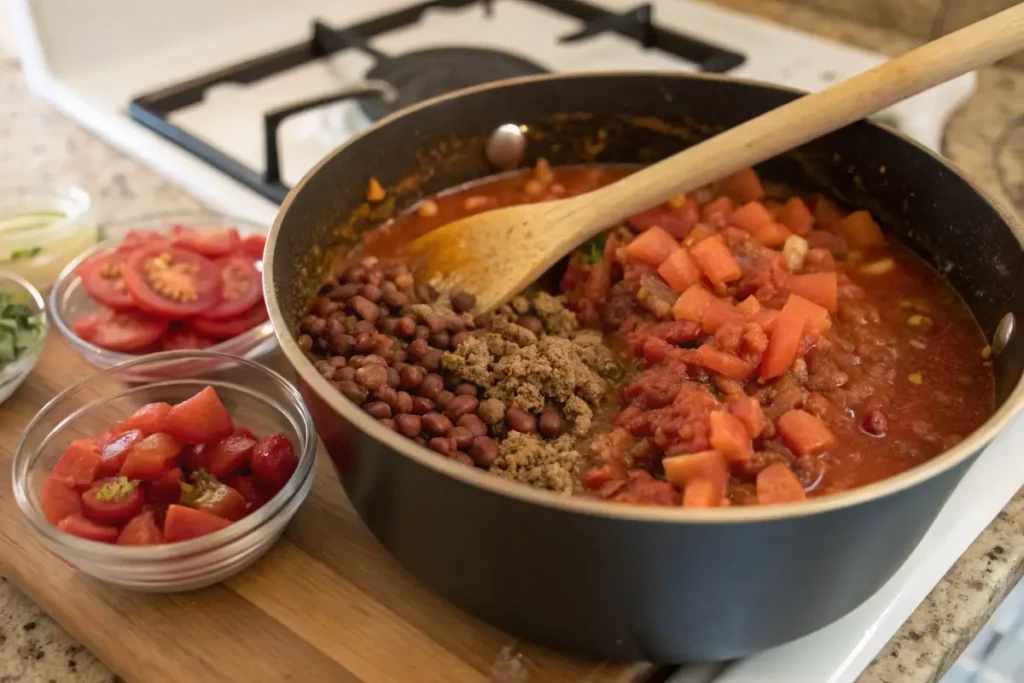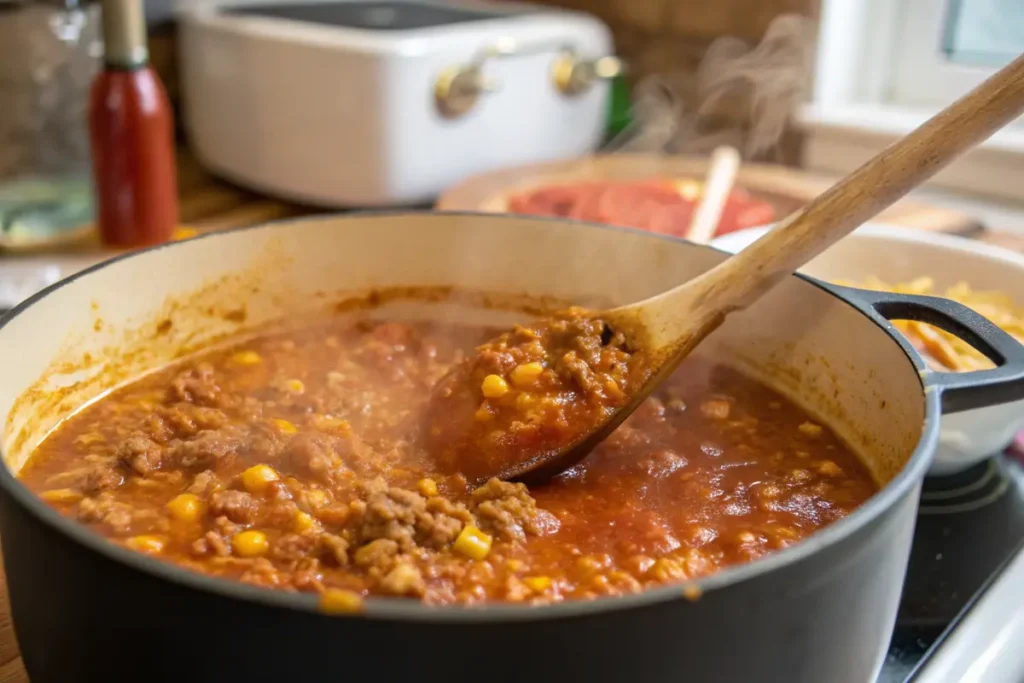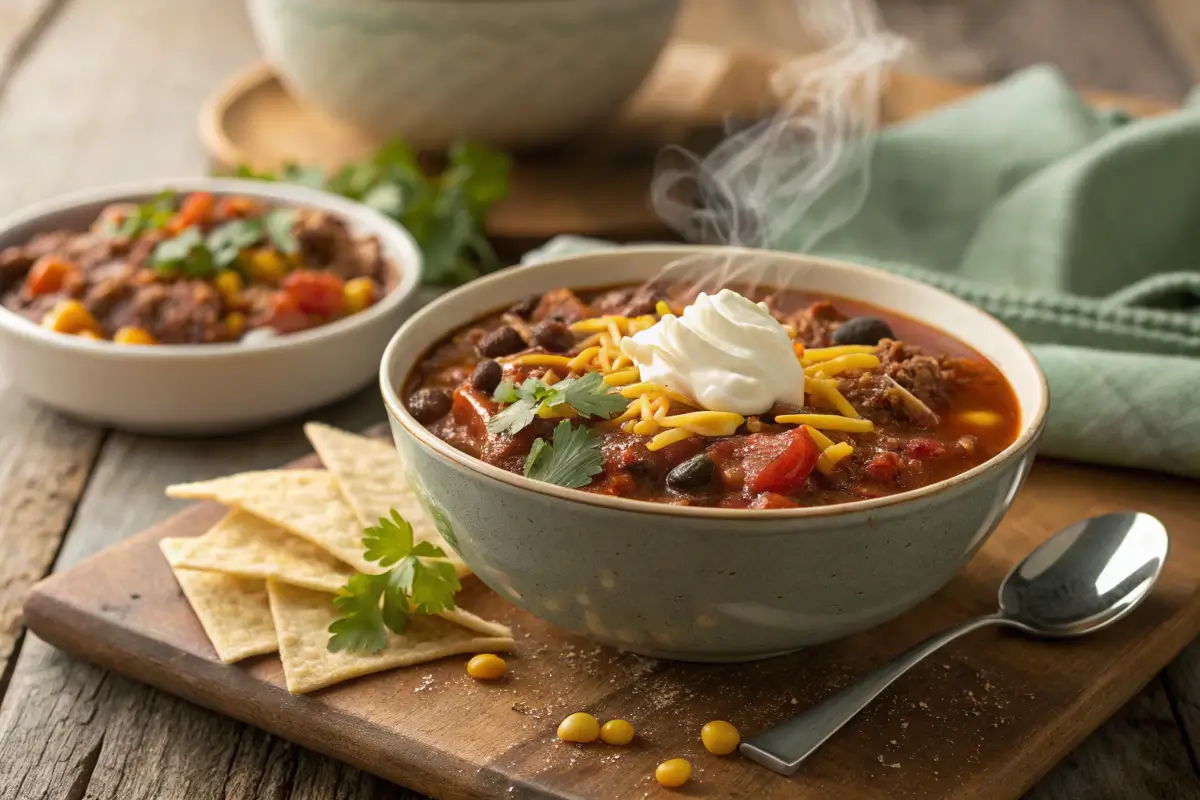Introduction
Have you ever ladled a bowl of taco soup, only to wonder, “Why is my taco soup so watery?” It’s frustrating, right? You’re expecting a hearty, thick soup bursting with flavor, but instead, it’s more like a thin broth. Don’t worry—you’re not alone, and this is an easy problem to fix. In this guide, we’ll break down the common reasons for watery taco soup and how you can turn things around.
Looking for a perfect recipe? Check out this Taco Soup Frios Recipe for inspiration.
Understanding the Causes of Watery Taco Soup

Before we dive into solutions, let’s figure out why this happens. The answer to “Why is my taco soup so watery?” lies in a combination of factors, like ingredient choices and cooking techniques. Here’s a closer look at what might be going wrong.
Misjudging Liquid-to-Ingredient Ratios
One of the main reasons for watery taco soup is adding too much liquid compared to the solid ingredients. If you pour in too much broth or water without balancing it with beans, meat, or veggies, you’ll end up with soup that feels more like a stew trying to be soup. A good rule of thumb is to start with less liquid and add more as needed while cooking.
Overuse of High-Moisture Ingredients
Another sneaky culprit behind watery taco soup is high-moisture ingredients like tomatoes, onions, and even frozen vegetables. These ingredients naturally release water as they cook, especially when used in large amounts. If you’ve ever thought, “Why is my taco soup so watery?” after following a recipe exactly, this could be the reason.
Failing to Account for Ingredient Water Release During Cooking
Have you noticed that soup often looks thicker when you start cooking but thins out over time? This happens because ingredients like vegetables and proteins release water as they cook. If you don’t factor in this water release, your taco soup can easily lose its hearty texture, leaving you asking, “Why is my taco soup so watery?”
Ingredient Choices and Their Impact on Soup Consistency
Your ingredients play a massive role in how your taco soup turns out. Let’s talk about how to make better choices to avoid that dreaded watery texture.
Using the Right Kind of Vegetables
Fresh vegetables are a great addition to taco soup, but they can be tricky. For example, zucchini or squash might add too much water unless they’re sautéed first. Stick to firmer veggies like bell peppers or corn, which hold their texture better. Next time someone asks, “Why is my taco soup so watery?”, you’ll know that choosing the right veggies is key!
Choosing the Best Proteins for Texture
Ground beef, chicken, or turkey are common proteins in taco soup. However, if you don’t drain the fat properly, or if you use overly lean meats, they might contribute to an unbalanced texture. The meat should provide richness and help absorb some of the liquid, ensuring a thicker soup that leaves no room for asking, “Why is my taco soup so watery?”
Importance of Thickening Agents
Sometimes, no matter how well you plan, your taco soup might still be a little thin. That’s when thickening agents like cornstarch, flour, or masa harina come to the rescue. These can turn a watery soup into a flavorful, satisfying dish in no time. When you’ve got the right tools, you’ll never need to wonder, “Why is my taco soup so watery?” again!
Cooking Techniques That Influence Consistency
Sometimes the answer to “Why is my taco soup so watery?” isn’t about what you put in but how you cook it. Cooking techniques play a huge role in getting that perfect texture. Let’s look at some common mistakes and how to avoid them.
Simmering vs. Boiling
If you’re boiling your taco soup, that might be a big reason it’s turning out watery. Boiling can break down ingredients too quickly and release more water, thinning the soup. Instead, opt for a gentle simmer. Simmering lets the flavors develop and reduces the liquid slowly, giving you a thicker, richer soup. The next time you’re making taco soup, remember: keep it low and slow, and you’ll never have to ask, “Why is my taco soup so watery?” again.
Cooking Times and Their Effect on Texture
Cooking taco soup for too short a time can leave you with a watery consistency. Ingredients like tomatoes and beans need time to break down and blend with the broth. On the flip side, cooking too long can also thin your soup as veggies break down and release extra liquid. Finding the sweet spot is key. A solid 30 to 40 minutes on a simmer is usually just right. Stick to this range, and you’ll stop asking, “Why is my taco soup so watery?” for good.
Stirring and Its Role in Even Distribution
Believe it or not, how you stir your taco soup can affect the consistency. Stirring too often can break down softer vegetables, causing them to release more water. On the other hand, not stirring enough might leave ingredients unevenly distributed, making parts of the soup watery. Stir occasionally, but gently—treat your soup like a labor of love. With proper stirring, you won’t be scratching your head wondering, “Why is my taco soup so watery?”
Fixing Watery Taco Soup

Let’s say you’ve already made your soup, and it’s looking more like taco-flavored water. Don’t panic! There are several easy fixes to thicken it up and make it delicious again.
Immediate Remedies for a Quick Fix
When you’re in a rush and wondering, “Why is my taco soup so watery?”, the fastest fix is to reduce the liquid. Just simmer the soup uncovered for 10–15 minutes to let some of the water evaporate. You can also mash some of the beans or vegetables to naturally thicken the broth. These quick fixes are lifesavers when you need dinner on the table fast.
Adding Thickeners: Cornstarch, Flour, or Masa Harina
Thickening agents are a taco soup’s best friend. If you’re using cornstarch or flour, mix a tablespoon with cold water first to make a slurry, then stir it into the soup. Masa harina, a finely ground corn flour, is another great option—it thickens the soup while adding a subtle corn flavor. These methods work wonders and will make you forget you ever had to ask, “Why is my taco soup so watery?”
Adjusting Ingredients Post-Cooking
If your soup is still watery, try adding more solids. Extra beans, corn, or shredded chicken can soak up some of the liquid and improve the texture. Another option is to add grated cheese—it melts into the soup and thickens it while boosting the flavor. With a few tweaks, you’ll turn your
Discover even more tips on What Makes Taco Soup Thicker to enhance its texture.
Preventing Watery Taco Soup in Future Recipes
By now, you’ve probably asked yourself at least once, “Why is my taco soup so watery?” Maybe you’ve even tried some quick fixes, but wouldn’t it be great to avoid the issue altogether? In this section, I’ll share the best prevention tips so your taco soup comes out perfect every single time. Let’s get into it!
Tips for Proper Ingredient Measurement
One of the easiest ways to prevent watery taco soup is to measure your ingredients carefully. It’s tempting to eyeball your broth or water, but that’s how you end up with too much liquid. Stick to the recipe and measure everything out, especially the liquids. If you’ve ever wondered, “Why is my taco soup so watery?”, chances are it was because of an unbalanced liquid-to-solid ratio. Pro tip: Start with less broth than the recipe calls for, and add more as needed while cooking.
Ideal Cooking Methods to Retain Flavor and Thickness
How you cook your taco soup is just as important as what you put in it. Always simmer instead of boiling—this keeps the liquid from thinning out too much and helps the flavors develop beautifully. Another trick is to partially cover your pot while cooking. This allows steam to escape, reducing excess liquid while still trapping enough heat to cook your soup evenly. If you’re still asking yourself, “Why is my taco soup so watery?”, double-check your cooking method—it makes all the difference!
Testing Consistency Before Serving
Before you serve your taco soup, take a minute to test the consistency. Use a ladle to scoop up some soup and see how it coats the back of a spoon. If it’s too thin, you still have time to fix it (hello, masa harina or cornstarch). By testing your soup before serving, you’ll never have to wonder, “Why is my taco soup so watery?”, while your guests are already at the table.
FAQs
How can I thicken my taco soup?
There are several ways to thicken taco soup. Adding a thickening agent like masa harina, cornstarch, or flour works wonders. If you don’t have those on hand, mashing some of the beans or vegetables directly in the pot can create a thicker texture. Cheese and sour cream are also great options for adding richness and body to your soup.
How to fix soup that is too watery?
To fix watery soup, the quickest option is to simmer it uncovered to let the excess liquid evaporate. You can also add thickening agents like cornstarch or flour, or stir in extra beans, rice, or meat to soak up the liquid. If you’re still struggling, try pureeing part of the soup to give it a heartier texture.
How to thicken up watery taco meat?
If your taco meat is too watery, you can sprinkle in some cornstarch, flour, or even breadcrumbs to soak up the liquid. Cooking the meat on medium heat for a few extra minutes also helps reduce moisture. Another option is to add a small amount of tomato paste, which thickens the mixture while boosting flavor.
How do you reduce the liquid in soup?
Reducing liquid in soup is easy—just simmer it uncovered for 10–15 minutes to allow the excess water to evaporate. Stir occasionally to prevent sticking. You can also ladle out some of the liquid and replace it with more solid ingredients, like beans or vegetables, to balance the texture.
Conclusion
And there you have it—everything you need to prevent asking “Why is my taco soup so watery?” ever again. From measuring your ingredients correctly to mastering your cooking techniques, these tips will ensure your taco soup is always rich, hearty, and flavorful. Plus, you now have answers to all the common soup-thickening questions, so you’re ready for any challenge in the kitchen!
With these prevention tips and a little practice, watery taco soup will be a thing of the past. Happy cooking, and here’s to many bowls of perfectly thick taco soup in your future!

